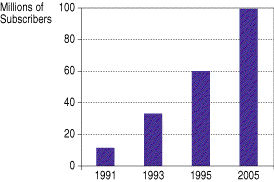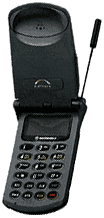
Definitions:
Analog technology is a method of modulating radio signals so that they can carry information such as voice or data. This electronic transmission mechanism takes place by adding signals of different frequencies or amplitude to carrier waves of a given frequency. In the past, broadcast and phone transmission have for the most part used analog technology. The analog concept also denotes fluctuations, evolutions, and continually changing processes. Analog is regularly represented by a series of waves. These analog waves mimic the wave forms of our voices.
Digital describes electronic technology that generates, stores, and processes data in two states: positive and non-positive. Positive is expressed or represented by the number 1 and non-positive by the number 0. Data transmitted with cellular phones that use this technology are expressed as a string of 0s and 1s. Each digit is known as a bit. A string of bits that constitute a group are known as a bite. Digital cellular phones take the voice of the user and encode it into a stream of data. The digital cellular service provider takes this stream of data, and converts it back into an analog signal, which the person at the other end of the phone call hears. This conversion process is the basis for many advanced wireless features, such as the availability of the Internet and e-mail on the user's cellular phone.
Analog phones have been around much longer than digital phones.
Their use today is much more extensive than the use of digital phones.
Even though, experts argue that digital phones will be the norm in the
future, it will be very hard to drive analog phones out the market.
There are many coverage areas that are only serviced by analogy systems.
It will take quite a few years for digital coverage to match the coverage
provided by analog networks.
No matter what technology we talk about, cellular communication is one
of the fastest and most demanding telecommunications applications.
Presently, there are more than 45 million cellular users worldwide, and
around 50% of those users are located in the United States. It has
been forecasted that cellular systems using digital technology will become
the universal method of telecommunications. Estimates predict that
there will be more than 100 million cellular subscribers around the world.
It has also been estimated that by the year 2000 some countries will have
more cellular phones in use than conventional phones. The following
figure shows the growth of cellular subscribers worldwide since 1991 and
predictions of coming years:

Advantages of Analog phones:
-Extensive
coverage area: because analog phones
have been around much longer, they have coverage virtually all around the
U.S. Additionally, analog
systems from all over
the country are compatible. This means that a user can travel around
without loosing service.
-More
equipment options: analog phones are made
by almost every wireless phone producer, in all shapes and sizes, and analog
phone will work on any analog
system in the U.S.
Digital phones, on the other hand, may be one of several different and
incompatible technologies, this can be a great problem when the user
wants to switch providers.
For example, if you bought GTE digital phone (TDMA) it won't work on Airtouch's
digital system (CDMA)
-Data Compatible: if you need to hook your phone up to your Palm Pilot to send a fax, you need an analog system.
-Less
Dropped Calls: analog is more elastic, in
the respect that when the signal is weak or distant, the elastic can be
"stretched" in which case there will be
some static and hiss,
yet the call can still go through. On the other hand, the signal
on digital phones is so thin, that if it is momentarily interrupted the
call
will result in a hang-up.
Disadvantages of Analog phones:
-Battery use: analog phones transmit signals continuously during communications, this causes their batteries to run out faster.
-Unable
to use future services:
cellular phones using
analog technology will not be able to use certain services that will only
be provided to digital users.
Services, such as Internet
and e-mail connection, will only be available for digital phones.
Phones that use support future services must be compatible with
other digital machines,
such as computers.
PICTURES OF ANALOG CELLULAR
PHONES


Advantages of Digital phones:
-Improved Call Quality: digital enhances voice clarity, filters background noise, and eliminates static.
-Security:
due
to the use of digital voice transmission, calls can not be scanned.
The issue of fraud is virtually eliminated by the CDMA system, which is
the most
secure wireless communications
technology available today.
-Improved Efficiency: digital phones require less power than analog phones. You will also get longer hours from you batteries.
-Dual
Mode Equipment: some digital phones are dual-mode,
which means that if you travel into an area not currently covered by a
digital network, your phone will
continue to operate on
the analog system.
-Ready
for Future innovations: firms providing digital
network services believe that digital phones will be able to support next-generation
services, such as
wireless Internet applications.
Disadvantages of Digital phones:
- Less Coverage Area: even though digital phone networks are growing rapidly, their coverage is not as extensive as that of analog phones.
- Less
Equipment Available: there are less accessories
available for digital phones than for analog phones.
PICTURES OF DIGITAL CELLULAR
PHONES


Links to Cellular Phone Manufacturers: